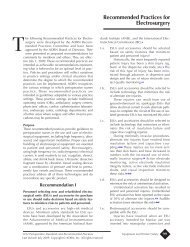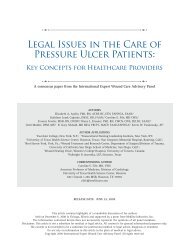2009 CAUTI guidelines - Centers for Disease Control and Prevention
2009 CAUTI guidelines - Centers for Disease Control and Prevention
2009 CAUTI guidelines - Centers for Disease Control and Prevention
You also want an ePaper? Increase the reach of your titles
YUMPU automatically turns print PDFs into web optimized ePapers that Google loves.
III. Implementation <strong>and</strong> AuditPrioritization of RecommendationsIn this section, the recommendations considered essential <strong>for</strong> all healthcare facilities caring <strong>for</strong>patients requiring urinary catheterization are organized into modules in order to provide moreguidance to facilities on implementation of these <strong>guidelines</strong>. The high-priority recommendationswere chosen by a consensus of experts based on strength of recommendation as well as on thelikely impact of the strategy in preventing <strong>CAUTI</strong>. The administrative functions <strong>and</strong> infrastructurelisted above in the summary of recommendations are necessary to accomplish the high priorityrecommendations <strong>and</strong> are there<strong>for</strong>e critical to the success of a prevention program. In addition,quality improvement programs should be implemented as an active approach to accomplishingthese recommendations <strong>and</strong> when process <strong>and</strong> outcome measure goals are not being metbased on internal reporting.Priority Recommendations <strong>for</strong> Appropriate Urinary Catheter Use (Module 1)• Insert catheters only <strong>for</strong> appropriate indications (see Table 2), <strong>and</strong> leave in place only aslong as needed. (Category IB)o Avoid use of urinary catheters in patients <strong>and</strong> nursing home residents <strong>for</strong>management of incontinence. (Category IB)o For operative patients who have an indication <strong>for</strong> an indwelling catheter, removethe catheter as soon as possible postoperatively, preferably within 24 hours,unless there are appropriate indications <strong>for</strong> continued use. (Category IB)Priority Recommendations <strong>for</strong> Aseptic Insertion of Urinary Catheters (Module 2)• Ensure that only properly trained persons (e.g., hospital personnel, family members, orpatients themselves) who know the correct technique of aseptic catheter insertion <strong>and</strong>maintenance are given this responsibility. (Category IB)• In the acute care hospital setting, insert catheters using aseptic technique <strong>and</strong> sterileequipment. (Category IB)Priority Recommendations <strong>for</strong> Proper Urinary Catheter Maintenance (Module 3)• Following aseptic insertion of the urinary catheter, maintain a closed drainage system(Category IB)• Maintain unobstructed urine flow. (Category IB)Per<strong>for</strong>mance MeasuresA. Internal Reporting. Consider reporting both process <strong>and</strong> outcome measures to senioradministrative, medical, <strong>and</strong> nursing leadership <strong>and</strong> clinicians who care <strong>for</strong> patientsat risk <strong>for</strong> <strong>CAUTI</strong>. (Category II)1. Examples of process measures:a) Compliance with educational program: Calculate percent of personnel whohave proper training:• Numerator: number of personnel who insert urinary catheters <strong>and</strong>who have proper training• Denominator: number of personnel who insert urinary catheters• St<strong>and</strong>ardization factor: 100 (i.e., multiply by 100 so that measure isexpressed as a percentage)18
















